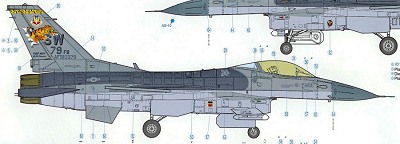
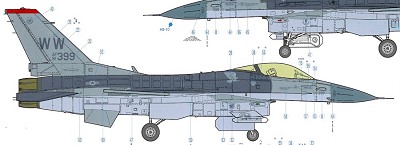
| KIT: | Tamiya 1/32 F-16C Block 50 Falcon |
| KIT #: | 60315 |
| PRICE: | $167.00 MSRP |
| DECALS: | Four options |
| REVIEWER: | Andrew Abshier |
| NOTES: | A block 50 F-16C shrunk down to 1/32 |


| HISTORY |
It's hard to believe that the YF-16 first flew over thirty years ago.
Selected in 1975 to fulfill a United States Air Force (USAF) for a
lightweight fighter to supplant the F-15A, the type has gone on to become
virtually the backbone of the USAF's modern tactical capability. Over the
years the F-16 has evolved from a relatively simple day fighter into a
multi-role aircraft, equally as capable in close-support missions as it was
in air superiority.
In the process, though, of expanding the roles of the F-16, the USAF found
that the weight of the additional weaponry and systems on the F-16 degraded
performance. The USAF had anticipated the requirement for more power, and
had launched development of a more powerful version of the General Electric
F-110 engine, which resulted in an engine that developed 33% more power at
high subsonic speeds than the earlier F-110 engine. The new engine was
incorporated into the F-16C Block 50 aircraft, which first flew in 1991 and
entered USAF service in 1993. In addition to the new engine, the Block 50s
featured a new head-up display, a more reliable radar, and, most
importantly for the USAF, the capability for flying Suppression of Enemy
Air Defense (SEAD) missions by the use of an AN/ASQ-213 targeting pod and
the AGM-88 High-Speed Anti-Radiation Missle (HARM). This capability
enabled the USAF to replace the last of their F-4 Phantoms, the F-4G, in
the SEAD role.
The new Block 50s saw action for the first time in 1995 in Iraq as part of
Operation Provide Comfort, the enforcement of the United Nations-mandated
no fly zones, and
over Bosnia in 1995 as part of Operation Deliberate Force. The type has
also had an integral role in the current hot zones of Afghanistan and Iraq,
as part of Operation Enduring Freedom and Operation Iraqi Freedom,
respectively. Block 50s remain in production, and are slated to replace
earlier blocks of the F-16 in USAF service. In addition, Greece, Turkey,
and Israel operate Block 50 F-16s, and Chile is slated to take delivery of
the type in 2006.
| THE KIT |
In 1979 Hasegawa produced the first kit of the F-16A in 1/32nd scale. At
that time it was hailed as one of the finest model kits ever produced, and
even now it is a reasonable starting point for an early-production standard
F-16A. Rather like the actual aircraft's growth in capability over its
years of service, the Tamiya kit shows the advances made in plastic molding
engineering and kit presentation.
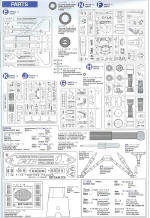
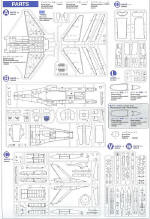 Where to begin? It's useful to visit the kit's
page on the Tamiya America website. They do a nice run-down of the
kit's many features, so repeating them here is unnecessary. Other sites
also have
full sprue shots, so again these won't be repeated here. What I hope
to do here is add some details that have not been mentioned in other
previews to date.
Where to begin? It's useful to visit the kit's
page on the Tamiya America website. They do a nice run-down of the
kit's many features, so repeating them here is unnecessary. Other sites
also have
full sprue shots, so again these won't be repeated here. What I hope
to do here is add some details that have not been mentioned in other
previews to date.
The box used is the same size as Tamiya's other jet kits. The first thing
I noticed is that there are NO parts or sprues rattling around inside.
This box is solidly packed with parts: 18 sprues with 526 parts, 25 cast
metal parts, seven rubber tires, and two photo-etch frets--total parts
count is 582! The amazing part is, virtually all of the parts are needed
to complete the model; on the sprue map, only 8 parts are marked as
unneeded. Dedicated Block 50 components, such as the AN/ASQ-213 HARM
targeting pod (mounted on station 5A on the intake), instrument panel, side
consoles, and ordinance, are molded on their own individual sprues, which
clearly suggests that other variants of the F-16 are forthcoming. The
fuselage is also split into forward and aft sections, which hints at some
two-seaters in our future.
Molding overall is excellent. I saw no flash anywhere on my example, and
thankfully the short-shots on the vertical tail, noted by other reviewers,
was not present on my sample. Tamiya needs to send their ejector-pin
people to Trumpeter; I found very few visible marks, and most of these were
on just one side of the main wheel well bulkheads. The cast-metal landing
gear struts have virtually no visible casting seam whatsoever, and mold
seams are very subtle on all of the plastic parts. Engraving is spot-on,
and the rivet detail (listening, Trumpeter?) is wonderfully subtle.
Detailing inside and out is excellent. The control stick and throttle have
to be seen to be appreciated; both are "busy" with knobs and switches as in
the actual aircraft and it looks like Tamiya got them all! Switch and
knob detail on the side consoles is equally as good. Interior detail is
provided wherever it can be seen, and that includes the fuselage interior
where the engine is placed. Pre-cut metal shafts are provided for all of
the static discharge ports, and the pitot tube is a turned metal part!
Seatbelt buckles are provided on the photo etch fret (buckles enough for
two seats...hmmmm) and pre-printed seatbelt material, with stitching
detail, is provided on the canopy mask sheet. Both clear and gold-tinted
canopies are provided, molded to the correct 210 degree configuration.
There are a few anomalies on the kit, all of which are minor. Some posters
at Hyperscale have pointed out that the panel lines on the right aft
fuselage are slightly inaccurate; perhaps so, but only a real F-16
aficionado (or crew chief) is going to notice. The instrument panel's
round instruments lack detail inside the bezels, and there are no decals
included for those instruments; in a pinch, the larger Reheat bezels from
their 1/48 scale set should work. The weapons included are excellent, but
the package lacks an AN/ALQ-131 jamming pod, which was very common on Block
50s flying Operation Southern Watch missions over Kosovo in the 1990s.
Finally, the decal placement instructions, printed in color on a
poster-size insert, show the aircraft in the factory-delivered color scheme
of gunship gray and medium gray upper surfaces with light ghost gray
undersides. While correct for a factory-fresh aircraft,
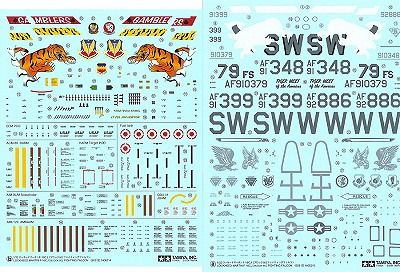 the four subjects
portrayed were all 10 years on from their delivery dates, which almost
certainly meant that they had undergone overhauls, and USAF F-16s
post-overhaul have been repainted into a two color scheme of Medium Gray
overall with Gunship Gray for the upper surfaces aft of the canopy. The
79th FS/Tiger Meet aircraft is two colors, and I strongly suspect the
three OIF aircraft also depicted were in two colors also. As always, check
those references!
the four subjects
portrayed were all 10 years on from their delivery dates, which almost
certainly meant that they had undergone overhauls, and USAF F-16s
post-overhaul have been repainted into a two color scheme of Medium Gray
overall with Gunship Gray for the upper surfaces aft of the canopy. The
79th FS/Tiger Meet aircraft is two colors, and I strongly suspect the
three OIF aircraft also depicted were in two colors also. As always, check
those references!
Speaking of decals, while they are well printed, they are on standard
Tamiya decal stock, which is thick. They actually work better than one
might think, having used them on other Tamiya kits, and would probably do
fine on the F-16. That said, aside from the Tiger Meet aircraft, the
subjects are rather blah, consisting of two 35th Wing aircraft and one 20th
Wing aircraft from Operation Iraqi Freedom, none of which have much in the
way of special markings beyond mission markings.
Despite all the complexity, this kit should go together nicely, if past
Tamiya kits are any indication. You'll have a lot to do but it should all
be pleasurable!
| CONCLUSIONS |
I've been a huge fan of the F-16 ever
since I got to see the first prototype, fresh from the 1975 Paris Air show,
at the Fort Worth, Texas plant. After all these years even these newer
airplanes festooned with all the latest instruments of warfare have always
remained true to the first one's sleek and refined lines. Had I been able
to follow my ambition to fly in the USAF, I would have killed to have
gotten my hands on an F-16. Alas, that is for another lifetime!
This is by far the most expensive model I have ever purchased, and my
girlfriend, who has been very understanding of my hobby, nonetheless posed
the obvious question, "is this kit worth the money?" Without hesitation:
YES. Like the Hasegawa kit was in its day, this kit by Tamiya is truly a
"kit of the year". This kit is truly a deluxe presentation, and looks like
it will provide a lot of enjoyment in the process of building it. Even if
you don't build it (and NONE of us have unbuilt kits in our stash, right?)
it's worth seeing just for the molding and presentation alone. Either way,
I recommend it without reservation!
February 2005
| REFERENCES |
F-16.net--The
Ultimate F-16 Reference
Sweetman, Bill: "Lockheed-Martin F-16: Block 40 and Beyond"; World Air
Power Journal, Volume 26, Spring 1999, Airtime Publishing Ltd.
Coremans, Danny, and Deboeck, Nico: Uncovering the Lockheed-Martin F-16
A/B/C/D. Daco Products Division, 2001
If you would like your product reviewed fairly and quickly by a site that has nearly 300,000 visitors a month, please contact me or see other details in the Note to Contributors.